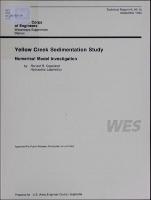Please use this identifier to cite or link to this item:
https://hdl.handle.net/11681/13589Full metadata record
| DC Field | Value | Language |
|---|---|---|
| dc.contributor | United States. Army. Corps of Engineers. Nashville District | - |
| dc.contributor.author | Copeland, Ronald R. | - |
| dc.date.accessioned | 2016-08-18T19:14:19Z | - |
| dc.date.available | 2016-08-18T19:14:19Z | - |
| dc.date.issued | 1993-09 | - |
| dc.identifier.uri | http://hdl.handle.net/11681/13589 | - |
| dc.description | Technical Report | - |
| dc.description | Abstract: Yellow Creek is located in the southeastern Kentucky coal mining region. Its major tributaries, Stony Fork and Bennetts Fork, are steep mountain streams that rise in the Cumberland Mountains near the Kentucky-Tennessee-Virginia tri-state corner and converge in a bowl-shaped valley that contains the city of Middlesboro, KY. In 1939, the U.S. Army Corps of Engineers completed construction of a 3.9-mile bypass channel around the town. Coal strip mines and spoil areas in the rugged bills have been the source of heavy sediment loads that have historically deposited in the flat-bottomed, trapezoidal bypass channel. Sediment aggradation bas been so great that maintenance dredging bas been conducted at least four times in the past, the most recent being in 1978-79. Flood damage reduction alternatives for Middlesboro are currently being evaluated. One structural alternative is an enlarged channel immediately downstream of the city. A one-dimensional numerical model (TABS-1) was used to evaluate (a.) dredging options in the existing bypass channel upstream from Middlesboro; and (b.) potential aggradation and/or degradation in the proposed improved channel downstream from Middlesboro. The numerical model was adjusted to simulate measured aggradation in the upstream reaches of the project and to simulate conditions in the existing downstream reaches of the project where there is no apparent aggradation or degradation trend. Alternative dredging cross-section options were determined using a new numerical model for hydraulic design called SAM. The design channel was then incorporated into the TABS-1 numerical model for evaluation. Maintenance requirements for the bypass channel were determined, and zones of aggradation and degradation in the improved channel reaches were identified. Proposed modifications to the improved channel design were tested in the numerical model. A more efficient design in terms of sediment transport was recommended. The original project design flood profile was also checked using the stable channel template. Appendix A describes the TABS-1 computer program. | - |
| dc.publisher | Hydraulics Laboratory (U.S.) | - |
| dc.publisher | Engineer Research and Development Center (U.S.) | - |
| dc.relation | http://acwc.sdp.sirsi.net/client/en_US/search/asset/1027220 | - |
| dc.relation.ispartofseries | Technical report (U.S. Army Engineer Waterways Experiment Station) ; HL-93-14. | - |
| dc.rights | Approved for public release; distribution is unlimited. | - |
| dc.source | This Digital Resource was created from scans of the Print Resource | - |
| dc.subject | Channels | - |
| dc.subject | Channel maintenance dredging | - |
| dc.subject | Dredging | - |
| dc.subject | Flood control | - |
| dc.subject | Sedimentation | - |
| dc.subject | Deposition | - |
| dc.subject | Sediments | - |
| dc.subject | Streams | - |
| dc.subject | Rivers | - |
| dc.subject | Numerical models | - |
| dc.subject | Mathematical models | - |
| dc.subject | Stable channel design | - |
| dc.subject | Yellow Creek (Bell County, Ky. : River) | - |
| dc.subject | TABS-1 | - |
| dc.title | Yellow Creek sedimentation study : numerical model investigation | - |
| dc.type | Report | en_US |
| Appears in Collections: | Technical Report | |
Files in This Item:
| File | Description | Size | Format | |
|---|---|---|---|---|
| TR-HL-93-14.pdf | 7.35 MB | Adobe PDF |  View/Open |